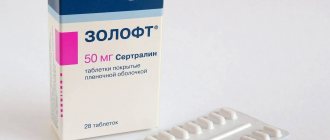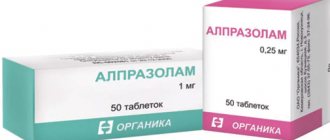Action of amitriptyline
The main effect of amitriptyline is antidepressant.
It also has a sedative (calming), hypnotic and anti-anxiety effect. It has no effect on a healthy person with a normal psychological state. These effects appear only in the presence of depression, restlessness, anxiety and insomnia, respectively. In addition to the effects of amitriptyline, there are other effects:
- Anesthetic.
- Vegetative stabilizing.
- Antidiarrheal (fixing).
- Removes psychosomatic symptoms: skin rash, high blood pressure, restores appetite, etc.
- Effective for some forms of enuresis (bedwetting).
Amitriptyline
Pharmacodynamic interaction
Concomitant use with serotonergic active substances (such as selective serotonin reuptake inhibitors (SSRIs) and norepinephrine (SSRIs), monoamine oxidase inhibitors (MAOIs), lithium preparations, triptans, tramadol, linezolid, L-tryptophan, St. John's wort preparations) may cause the development of serotonin deficiency. syndrome.
MAO inhibitors
Concomitant use of amitriptyline and monoamine oxidase inhibitors (MAOIs) can cause serotonin syndrome (agitation, confusion, tremor, myoclonus, hyperthermia are possible). Amitriptyline can be prescribed 14 days after stopping treatment with irreversible MAO inhibitors and at least 1 day after stopping therapy with the reversible MAO type A inhibitor, moclobemide. MAO inhibitors can be prescribed 14 days after stopping amitriptyline.
SSRIs
Caution must be exercised when using amitriptyline concomitantly with SSRIs (fluoxetine, fluvoxamine). Their simultaneous administration leads to an increase in the concentration of amitriptyline in the blood plasma due to inhibition of the CYP2D6 isoenzyme involved in the metabolism of TCAs. Patients receiving such therapy should be under strict medical supervision due to the risk of toxic reactions.
Anticholinergic drugs
Because TCAs, including amitriptyline, may potentiate the effects of anticholinergics on the eye, central nervous system, bowel, and bladder, their concomitant use should be avoided due to the risk of paralytic ileus.
When taking TCAs in combination with anticholinergic drugs or antipsychotics, especially in hot weather, hyperexia may develop.
Sympathomimetics
Amitriptyline may enhance the effects of adrenaline, norepinephrine, ephedrine, isoprenaline, phenylephrine and phenylpropanolamine on the cardiovascular system. As a result, you should not use anesthetics, decongestants and other drugs containing these substances simultaneously with amitriptyline.
Drugs that reduce sympathetic activity
Amitriptyline may reduce the hypotensive effect of guanethidine, betanidine, reserpine, clonidine and methyldopa. When taking TCAs concomitantly, it is necessary to adjust antihypertensive therapy.
CNS depressants
When used simultaneously with Hi-histamine receptor blockers, clonidine, alcohol and barbiturates, the inhibitory effect on the central nervous system may be enhanced. Amitriptyline may enhance the effects of other drugs that depress the central nervous system.
Drugs that prolong the
QT
Concomitant use of amitriptyline and drugs that prolong the QT :
antiarrhythmics (quinidine), antihistamines (astemizole and terfenadine), some antipsychotics (especially pimozide and sertindole), cisapride, halofantrine and sotalol - increases the risk of developing ventricular arrhythmia.
Antifungal drugs
Antifungals such as fluconazole and terbinafine increase serum concentrations of tricyclic antidepressants and, consequently, their toxicity. Fainting and the development of paroxysms of ventricular tachycardia (torsade de pointes) are possible.
Barbiturates and inducers of microsomal liver enzymes
Barbiturates and other inducers of liver microsomal enzymes, such as rifampicin and carbamazepine, can increase the metabolism of TCAs, and as a result reduce the concentration of TCAs in the blood plasma and reduce their effectiveness.
Cimetidine and methylphenidate, as well as slow calcium channel blockers
When used simultaneously with cimetidine, methylphenidate and blockers of “slow” calcium channels, it is possible to slow down the metabolism of amitriptyline, increase its concentration in the blood plasma and develop toxic effects.
Neuroleptics
When co-prescribed with antipsychotics, it should be taken into account that TCAs and antipsychotics mutually inhibit each other's metabolism, lowering the threshold for convulsive readiness.
Indirect anticoagulants
With the simultaneous use of amitriptyline and indirect anticoagulants (coumarin or indadione derivatives), the anticoagulant activity of the latter may increase.
Glucocorticosteroid drugs
Amitriptyline may enhance depression caused by glucocorticosteroids (GCS).
Anticonvulsants
When used together with anticonvulsants, it is possible to enhance the inhibitory effect on the central nervous system, reduce the threshold of convulsive activity (when used in high doses) and reduce the effectiveness of the latter.
Antithyroid drugs
Due to the risk of arrhythmias, special caution must be exercised when prescribing amitriptyline to patients with hyperthyroidism or patients receiving antithyroid drugs.
The simultaneous use of amitriptyline and drugs for the treatment of thyrotoxicosis increases the risk of developing agranulocytosis.
Anticholinergics, phenothiazines and benzodiazepines
When used together with anticholinergic blockers, phenothiazines and benzodiazepines, a mutual enhancement of the sedative and central anticholinergic effects and the risk of epileptic seizures (lowering the threshold of convulsive activity) is possible.
Oral contraceptives
Estrogen-containing oral contraceptives and estrogens may increase the bioavailability of amitriptyline. To restore effectiveness or reduce activity, a dose reduction of either estrogen or amitriptyline may be necessary. However, discontinuation of the drug may be necessary.
Acetaldehyde dehydrogenase inhibitors
Concomitant use with disulfiram and other acetaldehyde dehydrogenase inhibitors may increase the risk of developing psychotic conditions and confusion.
Phenytoin
TCAs may increase serum concentrations of phenytoin and, accordingly, increase the risk of its toxic effects (ataxia, hyperreflexia, nystagmus, tremor).
St. John's wort
The simultaneous use of amitriptyline and drugs containing St. John's wort can lead to increased metabolism of amitriptyline and a decrease in the maximum serum concentration of amitriptyline by 20%, due to the induction of its metabolism by the liver isoenzyme GYP3A4. Theoretically, it is possible to increase the risk of serotonin syndrome.
Lithium
With the simultaneous use of lithium preparations and tricyclic antidepressants, the risk of psychotic symptoms and toxic complications from the central nervous system may increase, even at therapeutic concentrations of lithium in the blood plasma. Cases of mania, myoclonus, tremor, tonic-clonic seizures, memory disorders, confusion, disorganization of thinking, hallucinations, serotonin syndrome and neuroleptic malignant syndrome, which began a few days after the start of combination therapy, were described; in most cases, discontinuation of therapy or TCAs was required, or lithium drugs. Elderly patients are especially prone to such reactions.
Indications for use
As doctors and scientists accumulate experience in the use of amitriptyline and clarify the mechanisms of development of many diseases, the indications for its use are constantly expanding. Main indications:
- Endogenous depression.
- Depressive psychosis.
- Anxiety disorders: generalized anxiety disorder, panic disorder, phobias, obsessive-compulsive disorder.
- Organic anxiety and depression.
- Schizotypal disorder, schizophrenia with depressive symptoms.
- Addictions (alcohol, drug, polydrug addiction).
- Neuroses.
- Personality disorders (psychopathy).
- Somatoform and psychosomatic diseases.
- Eating disorders.
- Pain syndrome.
- Enuresis.
AMITRYPTYLINE ZENTIVA
Interaction
Combined use with serotonergic active substances (such as SSRIs, SSRIs, MAO inhibitors, lithium preparations, triptans, tramadol, linezolid, L-tryptophan, St. John's wort preparations) may cause the development of serotonin syndrome.
Monoamine oxidase inhibitors
Concomitant use of amitriptyline and MAO inhibitors can cause serotonin syndrome (agitation, confusion, tremor, myoclonus, hyperthermia are possible). Amitriptyline can be prescribed 14 days after stopping treatment with irreversible MAO inhibitors and at least 1 day after stopping therapy with the reversible MAO type A inhibitor, moclobemide.
MAO inhibitors can be prescribed 14 days after stopping amitriptyline.
Selective serotonin reuptake inhibitors
Caution must be exercised when co-using amitriptyline with selective serotonin reuptake inhibitors (fluoxetine, fluvoxamine). Their simultaneous administration leads to an increase in the concentration of amitriptyline in the blood plasma due to inhibition of the CYP2D6 isoenzyme involved in the metabolism of TCAs. Patients receiving such therapy should be under strict medical supervision due to the risk of toxic reactions.
Anticholinergic drugs
Because TCAs, including amitriptyline, may potentiate the effects of anticholinergics on the eye, central nervous system, bowel, and bladder, their concomitant use should be avoided due to the risk of paralytic ileus.
When taking TCAs in combination with anticholinergics or antipsychotics, especially in hot weather, hyperpyrexia may develop.
Sympathomimetics
Amitriptyline may enhance the effects of adrenaline, norepinephrine, ephedrine, isoprenaline, phenylephrine and phenylpropanolamine on the cardiovascular system. As a result, anesthetics, decongestants and other drugs containing these substances should not be used simultaneously with amitriptyline.
Drugs that reduce sympathetic activity
Amitriptyline may reduce the hypotensive effect of guanethidine, betanidine, reserpine, clonidine and methyldopa. When taking TCAs concomitantly, it is necessary to adjust antihypertensive therapy.
CNS depressants
When used simultaneously with Hi-histamine receptor blockers, clonidine, alcohol and barbiturates, the inhibitory effect on the central nervous system may be enhanced. Amitriptyline may enhance the effects of other drugs that depress the central nervous system.
Drugs that prolong
the QT
interval The simultaneous use of amitriptyline and drugs that prolong the QT interval - antiarrhythmics (quinidine), antihistamines (astemizole and terfenadine), some antipsychotics (especially pimozide and sertindole), cisapride, halofantrine and sotalol - increases the risk of developing ventricular arrhythmia.
Antifungal drugs
Antifungal drugs, for example, fluconazole, terbinafine, increase the serum concentration of tricyclic antidepressants and, accordingly, their toxicity. Fainting and the development of paroxysms of ventricular tachycardia ( torsade
de pointes ) are possible.
Barbiturates and inducers of microsomal liver enzymes
Barbiturates and other inducers of microsomal liver enzymes, such as rifampicin and carbamazepine, can increase the metabolism of TCAs, and as a result, reduce the concentration of TCAs in the blood plasma and reduce their effectiveness.
Cimetidine, methylphenidate and slow calcium channel blockers
When used simultaneously with cimetidine, methylphenidate and blockers of “slow” calcium channels, it is possible to slow down the metabolism of amitriptyline, increase its concentration in the blood plasma and develop toxic effects.
Neuroleptics
When co-prescribed with antipsychotics, it should be taken into account that TCAs and antipsychotics mutually inhibit each other's metabolism, lowering the threshold for convulsive readiness.
Indirect anticoagulants
With the simultaneous use of amitriptyline and indirect anticoagulants (coumarin or indadione derivatives), the anticoagulant activity of the latter may increase.
Glucocorticosteroid drugs
Amitriptyline may enhance depression caused by glucocorticosteroids (GCS).
Anticonvulsants
When used together with anticonvulsants, it is possible to enhance the inhibitory effect on the central nervous system, reduce the threshold of convulsive activity (when used in high doses) and reduce the effectiveness of the latter.
Antithyroid drugs
Due to the risk of arrhythmias, special caution must be exercised when prescribing amitriptyline to patients with hyperthyroidism or patients receiving antithyroid drugs.
Concomitant use with drugs for the treatment of thyrotoxicosis increases the risk of developing agranulocytosis.
Anticholinergics, phenothiazines and benzodiazepines
When used together with anticholinergic blockers, phenothiazines and benzodiazepines, a mutual enhancement of the sedative and central anticholinergic effects and the risk of epileptic seizures is possible (lowering the threshold of convulsive activity)
Oral contraceptives
Estrogen-containing oral contraceptives and estrogens may increase the bioavailability of amitriptyline. A dose reduction of either estrogen or amitriptyline may be necessary to restore efficacy or reduce toxicity. However, discontinuation of the drug may be necessary.
Acetaldehyde dehydrogenase inhibitors
Concomitant use with disulfiram and other acetaldehyde dehydrogenase inhibitors may increase the risk of developing psychotic conditions and confusion.
Phenytoin
TCAs may increase serum concentrations of phenytoin and, accordingly, increase the risk of its toxic effects (ataxia, hyperreflexia, nystagmus, tremor).
St. John's wort
The simultaneous use of amitriptyline and drugs containing St. John's wort can lead to increased metabolism of amitriptyline and a decrease in the maximum serum concentration of amitriptyline by 20 %,
due to the induction of its metabolism by the liver isoenzyme CYP3A4. Theoretically, it is possible to increase the risk of serotonin syndrome.
Lithium
With the simultaneous use of lithium drugs and TCAs, the risk of psychotic symptoms and toxic complications from the central nervous system may increase, even against the background of therapeutic concentrations of lithium in the blood plasma. Cases of mania, myoclonus, tremor, tonic-clonic seizures, memory disorders, confusion, disorganization of thinking, hallucinations, serotonin syndrome and neuroleptic malignant syndrome, which began a few days after the start of combination therapy, have been described; in most cases, discontinuation of therapy with either TCAs or lithium preparations was required. Elderly patients are especially prone to such reactions.


